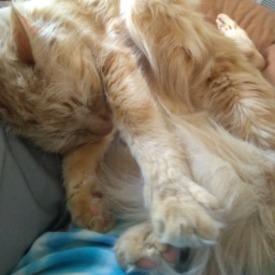Plantar Fascitiis

76Crane76
Posts: 133 Member
This is my second bout with PF. First time around I did all the traditional "fixes"...boot, PT, massage, frozen water bottle...this time I am seeing a podiatrist and orthopedic doctor. Has anyone seen these doctors and if so what did they do for your PF?
0
Replies
-
Custom made supports inserts for my shoes. They are absolutely worth it! Also, if you are actively losing weight you need to go back every six months or so. Good news, at 300lbs I needed then to keep the pain away just walking. Now that I am down to 180lbs, I no longer need them.4
-
Where did you get the custom inserts? I've recently developed it and it's a *kitten*0
-
Depends on where it is. The PF inserts at the metatarsal in front and the calcaneous in back. The closer to the metatarsal it is, the easier it is to heal. The farther back it is the worse it is. Most problems are right at the insertion point to the calcaneous and this responds to therapy well. if you feel it way back on the heel that is a problem because the tissue is so thick there and does not respond well to taping, and physical therapy.
01) Avoid dorsiflexion when possible, especially if the area is farther back on the heel.
02) Tape if near insertion point or forward of that.
03) Do all the things you have been doing.
04) Most importantly see a DPM (preferred) or an MD. They will likely put you on a regimen of steroid shots. There is nothing wrong with this and it does work. The steroids can weaken tissue but it can be strengthened with exercise. If you don't already have them, orthotics will likely be prescribed.
05) You may be sent to PT. They can use ultrasound to heal tissue. Again it works better at PF insertion point forward rather then farther back on the heel. They may also use a Tens device for electro stimulation for pain relief.
Watch out for any practitioner who wants to get out the knife out of the gate. If your symptoms last more than 6 months, then there other non-surgical therapies that have had good outcomes. Of course weight loss helps also.1 -
I have had plantar fasciitis, off and on, for many many years.
I used to play soccer.
At one point, I decided I have finally had enough. I could not continue to hobble around for days every time after I ran. I had to see a doctor and seriously consider surgery.
So, I got on the internet and googled: PF and surgery.
EVERYthing I read said, 'Oh yeah, the surgery often works. But you'll never really walk or run the same again.'
Yikes! I did not want that.
But then, in the course of these searches, I came across an scientific journal article by a Dr. DiGiovanni from Rochester, NY. In the article, he said that stretching definitely is a central part of rehab and recovery. But it doesn't work for a lot of people.
So he devised a way to improve the stretch. Instead of having people stand on a step and let their heel drop, or prop themselves against a wall, with one leg back, and push. He had them use their hand. He had them sit, cross one ankle over the opposite quad, grab the front of the lifted foot, and pull back to feel a stretch along the bottom of the foot, with the toes bent back too!
Bending the toes back with the stretch is key because it intensifies the stretch.
He performed a trial. He recruited something like 100 people with intractable PF. They all had to have had their PF for at least a full year and been unable to get it better with any of the conventional stretches/methods. He had them do his stretch for something like 8 weeks, three or so times a day.
At the end of the trial, almost 90 percent of these people said their PF was either gone or "vastly improved."
It has worked for me too. Nothing else ever did. I do the stretch and I have Superfeet insoles in all my shoes. Insoles prevent you from aggravating the condition -- setting recovery back. PF heals slowly. You need the protection of arch-support insoles.
Internet search: DiGiovanni and plantar fasciitis stretch. You'll find descriptions of how to do it and pictures. (I now do the stretch by getting into "hero's pose" [yoga], with my toes on the floor and the sole of my foot facing the wall behind. It is a bet easier to do because you are doing both feet at once and, I think, the stretch is even better!)
Good luck. I was scared off of doctors and surgery by what I read.2 -
I second the stretches while sitting or laying in bed, in fact, don't get up in the morning and don't put any weight on it unless you stretch really well, with your toes pointed up towards you. I used to have it really bad, and mine was on the heel practically, so stretch even at night when you wake up enough to turn side to side, gentle but as much as possible, throughout the day, keep the fibers lond, because that's what damages and tears them and causing so much pain, when fascia contracts and gets torn under weight or pressure from walking, running, etc. If you sit down for even a few minutes, get into a habit of stretching before you get up, pull your toes up while keeping heel on the floor. And then the rest, rolling frozen water bottle, gel shoes inserts. Good luck, it's a nasty painful condition, but it's something that can heal.1
-
About that stretching before you get out of bed in the morning.
Very important, it turns out.
The plantar fascia does not heal very well during the day because it is always getting tweaked and torqued as you walk and run. So, the tears cannot mesh and start to mend.
At night, they do, however. At night, the bridged and the knitting of the damaged tissue does begin to occur. Only, it occurs short. Your foot has no pressure on it at night, and the bed covers over your feet make you point them down. Hence, the healing that occurs tends to occur in a shortened position. It is weak. So, you step out of bed in the morning, Much of the healing that took place over night tears again.
It's why the night boot works. The boot holds your foot with the sole in a more elongated position. It's why, the army, which once was the world's expert on PF, because they got so many chubby, out-of-shape kids in boot camp, and put heavy packs on their backs and marched them, used to give its soldiers with PF a pair of stiff, new boots to wear in bed at night.
Stretching before you put your foot on the floor in the morning helps prevent that reinjury from happening.2 -
Yoga fixed mine! No boot, but I always use super feet insoles in my sneakers. Also got rid of most of my flats & bought higher quality shoes for work. Flip flops kill me, so I switched to Birkenstocks for around the house & outside, too:-)1
-
I have suffered twice from this and first time I went through all the usual - tennis ball, frozen bottles, special inserts etc. However, the one thing that fixed it both times was Cortisone injections into my heal. This was an almost instant fix, I kid you not. Injections one day, not sore the next - absolutely amazing. Don't waste your time with all the other fixes that don't work, ask your doctor about Cortisone injections today. You might think that the injections would be sore but for anyone who has suffered from Plantar Fasciitis, the injections are nothing compared to the original pain.
1 -
Don't waste your time with all the other fixes that don't work, ask your doctor about Cortisone injections today.
Steroid injections don't fix the underlying cause of PF, they mask the symptoms temporarily. More on that here:
https://runnersworld.com/injury-treatment/should-you-fear-cortisone 2
2 -
I had PF for about a year. I tried all the things recommended with no relief. I finally went to the podiatrist where he had custom shoe inserts made for me. They helped a lot, but I still had pain. After a few weeks, he gave me the steroid shot and that took care of it. That was almost 2 years ago and still no more pain. He also told me that my PF was from my daily treadmill workouts and to stop doing them, which I did.1
-
I have custom inserts that were fitted and provided by my podiatrist.1
-
I had PF for about a year. I tried all the things recommended with no relief. I finally went to the podiatrist where he had custom shoe inserts made for me. They helped a lot, but I still had pain. After a few weeks, he gave me the steroid shot and that took care of it. That was almost 2 years ago and still no more pain. He also told me that my PF was from my daily treadmill workouts and to stop doing them, which I did.
My husband had to do the cortisone shots and he wished he would have done them sooner. It was the only thing that worked for him.1 -
I did all the traditional things to try to fix mine. Nothing worked very well. When I finally got my hypothyroidism diagnosed and got on medication, it was one of the first symptoms that went away. Plantar Fasciitis is a very common symptom of hypothyroidism.1
-
Tried30UserNames wrote: »I did all the traditional things to try to fix mine. Nothing worked very well. When I finally got my hypothyroidism diagnosed and got on medication, it was one of the first symptoms that went away. Plantar Fasciitis is a very common symptom of hypothyroidism.
Ditto here. As soon as my thyroid was treated, the pain vanished.0 -
I had it in both feet for over a year. Mine was resolved with acupuncture surprisingly as physio was not helping. My Physio suspects it was tight calves that caused it and now if I even feel a twinge I do the following stretches for a few days and it goes away. While inserts are great for many people the underlying cause can also be tightness from hips to calves putting strain on your feet.
http://www.njsportsmed.com/files/myrtl_routine.pdf0 -
I had it in both feet for over a year. Mine was resolved with acupuncture surprisingly as physio was not helping. My Physio suspects it was tight calves that caused it and now if I even feel a twinge I do the following stretches for a few days and it goes away. While inserts are great for many people the underlying cause can also be tightness from hips to calves putting strain on your feet.
That's why my podiatrist told me to stop using the treadmill. It was causing a strain on the leg muscles.
0 -
I have the same problems in the plantar of one foot (feels like a knife slicing through my heel) and the tarsals of the other foot..(feels like they are all broken.. which could be possible. I had a horse step on my foot and bend it in half over the side of a side walk when I was 16.. I never went to the doctor for it. It flairs up randomly now and can be excruciating.)
I push through the pain mostly. I don't like doctors.0 -
I had it in both feet for over a year. Mine was resolved with acupuncture surprisingly as physio was not helping. My Physio suspects it was tight calves that caused it and now if I even feel a twinge I do the following stretches for a few days and it goes away. While inserts are great for many people the underlying cause can also be tightness from hips to calves putting strain on your feet.
That's why my podiatrist told me to stop using the treadmill. It was causing a strain on the leg muscles.
So not actually addressing the source of the problem. That's disappointing.1 -
I had severe plantar facitis and I completely got rid of it by taking a foam rolling clinic and repeatedly foam rolling it after exercise as well as diet and nutrition focus. Fascia is an important part of staying healthy and being able to maintain working out. Look into how to maintain healthy fascia and you might get some good tips.0
-
Oh also look into making sure you are using appropriate shoes for the appropriate activities. This also helped considerably. I never found a need for finding the right shoes until I worked out consistently for a long period of time. Running shoes don't work great for much more than running so I got myself a pair of running shoes and a pair of crossfit/ heavy support on the outside for weight training shoes.1
-
I tried everything, but the cortisone shot was the one that worked. And I buy new running shoes every 3 months. Vionics makes great arch support shoes -- even flip flops.0
-
Oh, my gosh. Plantar fasciitis is horrible. I've had mine since January--thankfully, only in one foot! I tried everything: stretching, stopped running, used a tens machine on my foot, massaged my foot multiple times daily, iced my foot, dorsal and posterior night splints, used a golf ball for foot massaging, bought various over the counter shoe inserts.
None worked.
Finally, after 4 months, I went to a podiatrist and BEGGED for treatment. I have had the series of 3 cortisone injections. #1 and #2 did not work. The 3rd one worked--it's been 6 weeks and it's awesome! Thank goodness, because you can only have a total of 3 cortisone injections on each foot. I'm probably 90% better and I continue to massage my plantar fascia.
The other things that helped me:
1. Wearing Hokas at work and for my workouts. Get rid of clogs. No flat shoes/ flip flops
2. Get a pair of hard soled house slippers like haflinger's. Avoid walking barefoot. At all.
3. Get yourself some Superfeet shoe inserts (can be purchased at REI). While you're at it, get a pair of Superfeet flip flops, if you love flip flops. Game changer and they look good, too.
4. Have a pair of custom orthotics made
5. Continue to ice, stretch, and massage your foot even when it starts to feel better
6. Stretch your calves--tight calves can cause plantar fasciitis
7. If you're a runner, get your gait/ stride assessed at a running store, and get good shoes that help correct your gait problem
8. ALWAYS stretch your plantar fascia before you take your first step in the morning
I hope that some of this helps you. Others have given some really awesome suggestions, too.
Cheers!1 -
Custom inserts in all shoes or (got one expensive set from podiatrist used in most inflexible frequently worn shoe, much cheaper mail order on another for biking shoe, local running store for another cheap version for running shoes) or traded around as needed - no barefoot walking.
Took about a year, after probably 12 years of constant never totally healing and re-injury of some sort.
Backed off weighted workouts majorly.
Stretching as mentioned, ice after stretching after a workout still done.
After the year, walked around barefoot at house, removed inserts from shoes that were flexible and allowed feet to move as intended, kept inserts in stiff shoes (biking, boots, dress, ect).
Actually started barefoot running on treadmill, then Vibram FF shoes, then Merrill trail gloves, until discovered after ankle break un-even legs already in place that probably led to injury in first place and kept it going to injury so easily. So now height insert in all shoes, no barefoot, but minimalist running.
Still insert in hiking boots with no flexibility and extra weight from backpack, but stiff biking shoes back to natural.
You can heal - just like any tendon - gotta give it a rest - and considering it's used daily for walking - that's hard to do. And less blood supply too generally.0 -
I agree with the above post about weaning off insoles if possible. PF is often from wearing shoes with overly stiff, supportive soles (= most shoes), which prevents the arches from getting the "workout" they need while walking. More on that here, from a podiatrist. I'd avoid insoles for any activities that don't cause pain, wearing shoes with soles that easily flex. And if you don't walk enough, manually stretch your arches hourly, at least.
 1
1 -
Like others, I have suffered with PF. For years. At one point, I would literally crawl in the house because the pain was too much. I tried all the home remedies, (water bottle still in the freezer, golf balls all over the place, stretching on a stair or against a wall...) then started seeing a podiatrist. Continued on with home remedies, got inserts for my shoes, night brace, oral medications, cortizone shots. Finally, after almost a year, he told me, frankly the next step is surgery. I looked everything over for a few months, did my own research, went back with a paper full of questions, he answered all of them. I went on vacation walked all over New England & thought some more, and finally had it on Dec 2, 2016. Best decision I made (after my divorce! lol) I had no idea how much in spasm I was even when it wasn't "in flare"!
Now, I agree, everyone is different, but after all I went through, surgery was the best decision for me. Yes, I still stretch it out, still wear my inserts, but I walk normally, I run & cycle the same, can wear heels or flats, and all without pain.0 -
I'm a rebel: yoga 2-3x a week, Birkenstocks at home (no flats at work!!), and had already been only using Brooks Ghost w SuperFeet for running (fitted at FleetFeet). I stopped running just to be safe. Lost weight using MFP. Pain is gone! No shots- but if it came back, I would reconsider bc it is miserable.0
This discussion has been closed.
Categories
- All Categories
- 1.4M Health, Wellness and Goals
- 398.2K Introduce Yourself
- 44.7K Getting Started
- 261K Health and Weight Loss
- 176.4K Food and Nutrition
- 47.7K Recipes
- 233K Fitness and Exercise
- 463 Sleep, Mindfulness and Overall Wellness
- 6.5K Goal: Maintaining Weight
- 8.7K Goal: Gaining Weight and Body Building
- 153.5K Motivation and Support
- 8.4K Challenges
- 1.4K Debate Club
- 96.5K Chit-Chat
- 2.6K Fun and Games
- 4.8K MyFitnessPal Information
- 13 News and Announcements
- 21 MyFitnessPal Academy
- 1.6K Feature Suggestions and Ideas
- 3.2K MyFitnessPal Tech Support Questions




















